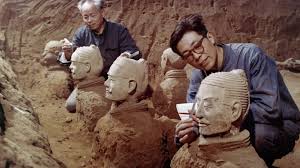
Who Discovered the Terracotta Army?
A Chance Discovery During a Drought
The year was 1974. A severe drought gripped the Lintong County of Shaanxi province, China. The parched earth yielded little, and water became a precious commodity. Faced with dwindling water supplies, a group of villagers, including a farmer named Yang Zhifa, decided to dig a well.
On March 29th, as Yang Zhifa plunged his shovel deep into the ground, it struck something hard. Unearthing the object, he was met not with the life-giving water he sought but with fragments of terracotta – baked clay. These were no ordinary shards, however. Intricately molded and fired, they depicted the unmistakable forms of ancient warriors.
The villagers, initially more concerned with their water woes, dubbed these figures "Wa Ye" meaning "Tile Grandpas" They had stumbled upon a discovery of unimaginable historical significance - the first traces of the legendary Terracotta Army.
A Glimpse of Ancient Splendor
Word of the "Tile Grandpas" soon reached the ears of local authorities and archaeologists. As they began to excavate the site, they were astonished by the sheer scale and magnificence of the find.
What emerged from the earth was an army frozen in time. Thousands upon thousands of life-sized terracotta soldiers, each unique in their facial features and posture, stood ready for battle. Horses, chariots, and weaponry accompanied the infantry, forming a complete military array.
However, the most breathtaking aspect of the discovery was the color. When first unearthed, the warriors were not the monotone terracotta we see today. They were adorned in vibrant pigments, their robes a kaleidoscope of reds, blues, greens, and yellows. Their faces were painted with lifelike detail, showcasing the artistry of the Qin dynasty.
Fading Glory: The Challenge of Preservation
Sadly, this spectacle of color was short-lived. The pigments used by the ancient artisans were organic and highly susceptible to oxidation upon contact with air. Within minutes of exposure, the vibrant hues began to fade, the colors literally evaporating before the eyes of the astonished archaeologists.
Preserving what remained of the colors became a priority. Frantic efforts were made to develop techniques to halt the oxidation process and retain the remaining traces of the pigments. While these efforts have met with some success, much of the original vibrancy of the Terracotta Army has been lost to time.
Despite the fading colors, the impact of Yang Zhifa’s accidental discovery remains undiminished. The Terracotta Army stands as a testament to the might and ambition of Qin Shi Huang, the first emperor of China, and continues to captivate and inspire awe in visitors from across the globe.
Q&A
1. What were the terracotta warriors initially called by the villagers who found them?
Answer: The villagers called them "Wa Ye," meaning "Tile Grandpas."
2. Why did the colors of the Terracotta Army fade after being excavated?
Answer: The organic pigments used to paint the warriors were susceptible to oxidation upon contact with air, causing the colors to fade rapidly.
3. What is the significance of the Terracotta Army in understanding ancient China?
Answer: The Terracotta Army provides invaluable insights into the military organization, weaponry, and artistic achievements of the Qin dynasty, offering a glimpse into the ambition and power of the first emperor of China.